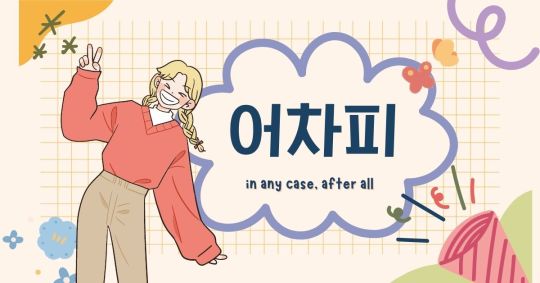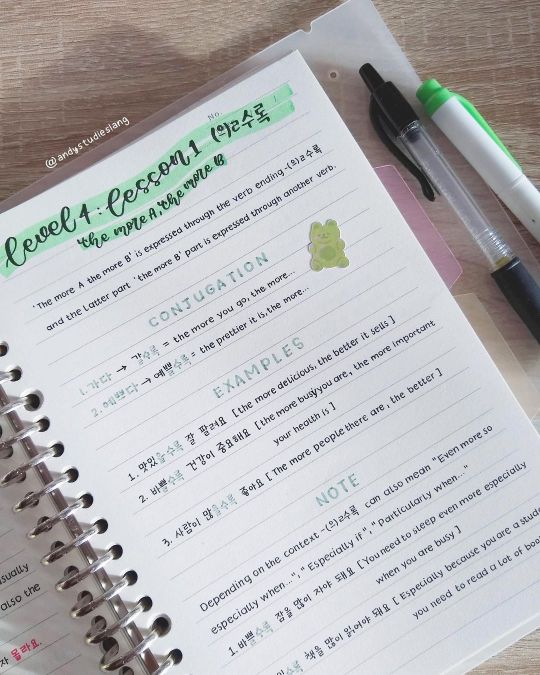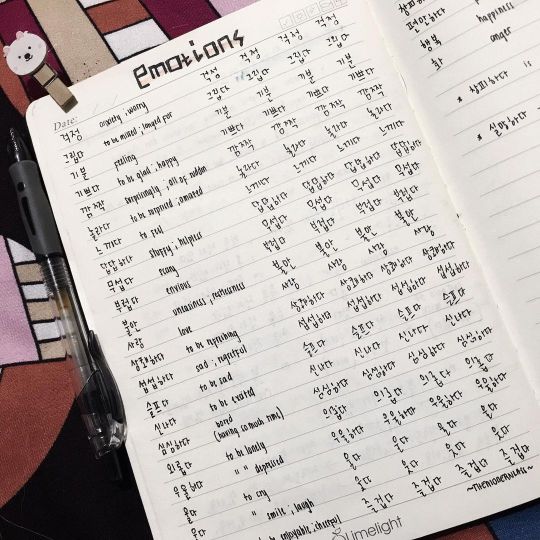#한국어공부
Photo

If you're learning Korean, you might have encountered the word "어차피" (eo-cha-pi) at some point. It's a useful word that can be translated to "anyway," "in any case," or "after all." When you use "어차피," you're often indicating that something is inevitable or necessary, regardless of other circumstances.
To use "어차피", you simply need to add it to the sentence.
E.g.
어차피 늦었으니까 천천히 와.
(It's late anyway, so take your time.)
어차피 다른 선택지가 없어.
(There’s no other option anyway.)
그 사람은 어차피 나를 싫어하는 거야.
(That person hates me, after all.)
"어차피" is often used with grammar like ~(으)니까 or -(으)ㄴ/는데 to add more context.
E.g.
어차피 해야 할일이니까 빨리 하고 끝내는게 좋지않겠어요?
(Because it's something you have to do anyway, isn't it better to hurry up and finish it?)
어차피 시간이 없는데 일찍 가는 게 좋을 거야.
(Anyway, since we don't have much time, it's better to leave early.)
어차피 지나간 일이니까 다시 말하지 말아요.
(Since it's a thing of the past anyway, let's not talk about it again.)
어차피 밖에 비가 내리고 있는데 조금더 이야기를 나누자
(It's raining outside anyway, so let's talk a little bit more.)
🌸 🌼 🌻
Support me at: https://koreanlanguageloving.my.canva.site/
#Korean Language#korean langblr#Learn Korean#Study Korean#Hangul#한국어 공부하기#한국어 배우기#한국어 어휘#한국어 연습#한국어#한국어능력시험#한국어공부해요#한국어공부중#한국어공부하기#한국어공부#Korean Vocabulary
344 notes
·
View notes
Text
vocab list: 미술
그림: painting, picture, drawing, sketch, illustration
페인팅: painting (영어)
페인트칠: painting (한국어)
그리다: to paint, draw, sketch a picture
끌다: to pull, draw/attract (someone's attention)
긋다: draw a line
만들다: to make (a movie, book, song), produce, direct (a movie), compose (a song)
사진: picture, photo
영화: picture, video, movie, film
영상: picture, video, image (shown on a screen)
화면: picture, image (space filled by a photo)
그림자: shadow, silhouette, reflection (on a mirror/water)
그늘: shade, dark part
미행: shadowing (secretly following someone to keep an eye on them or get evidence)
느끼다: to feel (experience an emotion in one's mind), realize, being aware of
기분: mood, feeling, atmosphere (the situation surrounding)
감정: emotion, feeling (towards a certain incident or person)
도자기: pottery, ceramics, chinaware (도기 is a bowl made of clay, and 자기 is baked at a higher temperature-1200°C-)
도예: abbreviation of '도자기 공예' -ceramic arts-
도기: pottery, earthenware
회: raw fish, round (ONLY when it's added to a number, aka a counter)
둥근: round, spheroid
차례: order, turn
계속: continuosly, consecutively
형태: shape, form, figure, appearance (of an object)
모양: shape (outer appearance/aspect) -mostly used-
형성하다: to form, build, develop a certain character or form
생기다: to be formed, come into being (something that didn't exist to come into existence)
예술: art (very broad sense, including music, painting, sculpture, architecture)
미술품: art work, fine art, work of art
미술: art (painting and sculpture)
기술: technology, skill, technique
닦다: to clean, scrub, wipe
양치: brushing teeth
붓: writing/painting brush
빗다: to brush/comb one's hair
비디오: video
텔레비전: TV
녹화: video, record, tape, videotape
무비: movie
원: circle; ₩
돌다: to turn, rotate, spin; to go around, circle
그룹: group, a circle (of people)
사회: society, circle
잉크: ink
서명하다: to sign
서명: signature, autograph
먹물: black ink (ink + water), squid ink
광장: square, plaza
사각형: square, quadrangle, tetragon, quadrilateral
평방: square (ej metros cuadrados)
제곱: square (of -maths-)
네모: square
조각: piece (of), slice; sculpture, statue
작품: piece (of music), work (of art); product, production
부분: piece, part, section, portion
하나: one, piece
하나씩: one by one, one at a time, piece by piece
일부: some/any part, portion, section, partially, partly
즐기다: to enjoy (oneself), have fun
하세요: do it, allowing someone to do something
누리다: authority to enjoy what you have in life; to enjoy someone's rights or benefits
즐겁게: delightfully
재미있다: funny, interesting, amusing, entertaining
점토: clay
진흙: mud
춤: dance (dynamic, b-boing, -방탄소년단-)
무용: dance (soft movement -ballet-)
추다: to dance
페인트: paint (pintura)
칠하다: to paint, coat, varnish
물감: paint, dye (to draw a picture or dye cloth)
색칠하다: to paint, color (something)
크레용: crayon
~을 크레용으로 그리다: to draw with crayons
~을 사생하다: to draw exactly as it is (not used in conversational korean)
주변 경치를 사생하다: draw exactly how it is viewed
사생대회: drawing/painting contest
납작한: flat (to be)
평면: plane/flat surface
아파트: flat, apartment
시시한: flat, petty, small minded; insignificant, trivial
한 푼 없는: have no money
포스터: poster
영화계: the film world (-hollywood-)
박막: a thin film (anatomical jargon)
촬영: shooting, filiming
필름: film (영화 필름, 카메라 필름, 휴대폰 액정보호 필름, etc)
행동하다: to act, behave
법률: law, act, legislation
연기하다: to act, perform (personality, behavior, etc of a role); to delay, postpone
행위: act, action (with intention, will)
대행하다: to do something for someone
source: 영단어는 관리다 app

#study#korean#koreanlanguage#koreanstudy#koreanstudying#한국어#한국어연습#한국어공부#한국어공부중#한국어배우기#korean language#한국어 배우기#한국어 공부하기#korean learning#korean langblr#learn korean#korean lesson#korean words#korean voca#korean vocabulary list#korean vocab#korean vocab list#korean vocabulary#한국어 단어#한국어 배우다#한국어 공부#한국어 어휘
296 notes
·
View notes
Text
공부 시간!
Hey! It's been... a while, I know. But I am back at studying 한국어 and it's time to study some vocabulary and practice by making sentences, so here we go!
어휘 (vocabulary):
방 (room)
교실 (classroom)
문 (door)
창문 (window)
책상 (desk)
의자 (chair/stool)
칠판 (blackboard)
지도 (map)
달력 (calendar)
시계 (clock)
거울 (mirror)
옷걸이 (clothes hanger/hanger)
컴퓨터 (computer)
텔레비전 (television)
책 (book)
공책 (notebook)
필통 (pencil case)
연필 (pencil)
색연필 (color pencil)
볼펜 (ballpoint pen)
지우개 (eraser)
돈 (money)
지갑 (wallet/purse)
가방 (backpack)
휴지 (toilet paper/waster paper)
신분 (identity)
증 (certificate/card)
신분증 (identity card/ ID card)
학생증 (student card)
휴대 전화 (cellphone)
사전 (dictionary)
잡지 (magazine)
여기 (here)
거기 (there [kinda far away])
저기 (there [far away])
이 (this [close])
그 (that [kinda far away)
저 (that [far away])
Okay! Now, let's make some 문장들 (sentences)!
For these sentences, the settings I have imagined are a 교실(classroom) and a 방 (room). Let's begin :)
1st scenario (방):
이 방은 누구의 방입니까? (whose room is this?)
내 방입니다. (It's my room).
그것이 무엇입니까? (What is that [kinda far away]?)
그것이 거울입니다. (That is a mirror.)
옷걸이도 있습니까? (Is there also a hanger?)
네, 옷걸이도 있습니다. (Yes, there is also a hanger.)
2nd scenario (교실):
여기는 우리 교실입니다. 이것이 문입니다. 저것이 창문입니다. 책상들이 있습니다. 의자들도 있습니다. (Here is our classroom. This is a door. That [far away] is a window. There are desks. There are also chairs.)
지도가 있습니까? (Is there a map?)
아니요, 지도가 없습니다. 하지만, 칠판이 있습니다 (No, there is no map. But there is a blackboard.)
시계도 없습니다? (There's no clock either?)
아니요, 시계이 있습니다. 칠판하고 책도 있습니다. (No, there is a clock. There is also a blackboard and a book).
3rd scenario (교실):
필통에 무엇 있습니까? (What's in the pencil case?)
필통에 연필이 있습니다. 볼펜도 있습니다. (There is a pencil in the pencil case. There is also a ballpoint pen.)
지우개도 있습니까? (Is there also an eraser?)
네, 지우개도 있습니다. (Yes, there is also an eraser.)
색연필도 있습니까? (Is there also a color pencil?)
아니요, 색연필 없습니다. (No, there is no color pencil.)
4th scenario (방):
가방에 무엇이 있습니까? (What's in the bag?)
가방에 내 지갑하고 필통이 있습니다. (In the bag are my wallet and my pencil case).
지갑에 무엇이 있습니까? (What's in the wallet?)
지갑에 돈이 있습니다. (There is money in the wallet.)
신분증도 있습니까? (Is there also an ID card?)
네, 신분증하고 학생증도 있습니다. (Yes, there's also an ID card and a student card.)
가방에 휴대 전화도 있습니까? (Is there a cellphone in the bag?)
아니요, 휴대 전화 없습니다. (No, there is no cellphone).
And that's it for today! It's fun to study Korean again :). If you see any mistakes please feel free to point them out, thank you!
Happy studying everyone, I wish you all a nice day! <3
88 notes
·
View notes
Text
Sad to see the loss of one of the largest free Korean language learning resource with Talk To Me In Korean moving to paid-only platform.
Since starting to learn Korean in 2016, I’ve witnessed huge improvements in the accessibility of free resources for Korean learners. TTMIK has been a huge part of the popularisation of Korean language learning.
My favourite free alternatives to TTMIK for learning Korean:
HowToStudyKorean.com (my all time favourite - I’ve used them since day 1)
King Sejong Institute textbooks (available for free online through 누리 세종학당)
#learning korean#korean language#korean#talk to me in korean#ttmik#한국어#한국어공부#한국어 공부하기#한국어 공부#한국어 배우기
39 notes
·
View notes
Text


02/2021 -> 11/2022
My korean handwriting has sure changed quite significantly 👀
#personal#studyblr#langblr#korean#study#korean studying#self study#study motivation#study notes#한국어배우기#한국어공부#한국어 연습
141 notes
·
View notes
Text
Word Of The Day: 운명
운명 Meaning Fate or Destiny
Here are some related words and phrases:
운명을 받아들이다 to accept one’s fate
(받아들이다 to accept/ to adopt/ to embrace / to agree)
운명을 같이하다 to be in the same boat as – to share the same fate
(같이하다 to share/ to join)
As I am not 100% fluent in Korean there could be some mistakes
Happy Studying Everyone! X
26 notes
·
View notes
Note
What is the difference between -게 하다 and -게 되다?
Great question! First, we need to understand that 하다 is active whereas 되다 is passive! Your next question might be, “but omg, SK101, I’m not good at English grammar, too; what the hell is passive and active?”
Another great question!
The active voice is when the speaker/subject performs the action or is described directly–they did it, caused it, performed it; you’re gonna see people commonly use these ways to explain the active voice. In English, the active voice can look something like this:
I studied Korean; (저는) 한국어를 공부했어요
As you can see, I (the subject) am the one that studied Korean of my own volition. I caused the “Korean studying.”
The passive voice is when the speaker/subject does not perform/cause/do the action. Instead, the subject is affected by the action/performance. I understand this may be difficult to understand, so I’ll spend more time on this.
When can you use the passive voice?
When we have more interest in the object that experiences the action
When we don’t know (or don’t want to express) who performed the action (this is an academic loophole when we didn't do the proper research to support a claim)
When we want to emphasize the action!
The passive voice is not grammatically incorrect (take it from a linguist and someone who minored in creative writing). You will hear people say that the passive voice is not good or is ungrammatical (some bs like that). Even in Korean, the passive voice is entirely natural and used in everyday contexts.
The passive voice in Korean may look like this:
한국어가 (저에게) 공부됐어요; Korean was studied (by me)
The prepositional phrase “by me; 저에게” shows that we know who studied Korean. This may still be confusing, so let me give you another example:
부엌을 청소했어요; I cleaned the kitchen.
부엌이 청소됐어요; The kitchen has been cleaned.
Let’s add more context to the sentence to understand the situation better.
집에 도착했을 때 부엌을 청소했어요; When I got home, I cleaned the kitchen (meaning, I saw the dirty kitchen and cleaned it)
집에 도착했을 때 부엌이 청소됐어요; When I got home, the kitchen was cleaned (meaning, someone (unknown or otherwise) cleaned the kitchen when I was out)
*gasp!* Yes, by now, you've noticed that 이/가 goes with passive!
Now, onto your question: what's the difference between -게 하다 and -게 되다?
-게 하다: causative
The causative aspect shows that A causes B to happen. Pretend you have a younger sibling–here are some examples:
동생은 저를 늦게 했어요; My sibling made me late
저는 동생이 문제를 이해하게 했어요; I made them understand the problem
저를 귀찮게 했어요; You (the sibling) bothered me!
(저는) 동생을 화장품으로 예쁘게 했어요; I made my sibling pretty with makeup
A (동생/저) causes B to happen. B does not mean the recipient (저/동생) of the action – B represents the action.
-게 되다; to become (passive)
This grammar point shows that B changes A! Let’s use the examples from above.
동생이 화장품으로 예쁘게 됐어요; my sibling became pretty with makeup
동생 때문에 제가 귀찮게 되었어요; my sibling has been bothering me
문제가 동생에게 이해하게 되었어요; my sibling came to understand the problem [more literally; the problem was understood by my sibling]
동생 때문에 제가 늦게 되었어요; I became late because of my sibling
Now, I'm sure you've noticed that there are two spellings of a conjugated '되다'. The only difference between '되었어요' and '됐어요' is that '됐어요' is a contraction of '되었어요'. You may have other Korean learners attempt to tell you that you write one [되었어요] and speak the other [됐어요]. This isn't not true; it's just not a rule written in stone. You are very much able to write the contracted '됐어요' instead of the regular '되었어요'. In fact, native Korean speakers do this all the time. It would be like saying we shouldn't write any English contractions because it's not grammatically correct--it's just wrong. The rules of '되다' are more complex than just written and spoken, but that's a blog for another day.
I hope this helped answer your question! If you're still confused, don't hesitate to send me another ask or pm me! I'm always open to clearing up any confusion or directing you to a source that may help!
Happy Learning :)
~ SK101
#korean blog#korean#korean language#learn korean#study korean#korean langblr#한국어#한국어 배우기#korean language blog#langblr#kblr#korean langauge#south korean#한국어 공부하기#한국어 문법#한국어공부#korean words#studyblr#-게 되다하고 -게 하다 차이#한국어 동사#문법#ask#물어보기 아논#물어보는 질문#질문#한국어 질문
197 notes
·
View notes
Text
안녕하세요~
저는 나 소개를 하고 싶어서 여기 할거예요!
영국에서 왔고 저는 19살이에요. 저는 크로셰와 독서를 좋아해요 근데 요즘에 시간 없어요 :(
일 년 동안 한 대학교에 한국어를 전공했는데 그 대학교 싫어서 구월에 다른 대학교 갈 거예요
여기서 저는 한국어 학습 팁을 공유할 것이고 우리는 함께 배울 수 있어요!
Hi everyone,
I wanted to introduce my self so I’ll do it here!
I’m 19 and I’m from England. I like crochet and reading but I don’t have much time for it these days :(.
I studied Korean at one university for a year but I didn’t like that university so I’m moving to a different one.
Here I’ll share korean learning tips and we can learn together!
#korean#korean learning#korean language#korean lesson#한국#한국어 연습#한국어공부#한국어#korean study#korean studies
17 notes
·
View notes
Text
~더니
~더니 has no English equivalent so it’s tricky to explainㅜㅜ It basically indicates that you’ve observed/noticed/experienced something in the past.
~더니
*not used with 1st-person tense
*can be used with either verbs or adjectives
1. cause and result
요즘 눈이 많이 오더니 아무도 언니가 엄마한테 선물로 새 외투를 받았어.
언니가 운동을 열심히 하더니 식욕이 왕성해졌어.
민주가 아까 약을 먹더니 지금은 좀 괜찮아졌네요.
걔가 계속 노름을 하더니 결국 가산을 탕진하고 말았어.
2. showing difference/changes from time passing
아침에는 춥더니 낮에는 덥네요.
어제는 비가 오더니 오늘은 하늘이 맑네.
걔가 작년에는 좀 뚱뚱하더니 지금은 날씬해졌어.
예린이가 아까까지만 해도 공부하고 있더니 지금은 노네.
~았/었더니
*can only be used with verbs
1st clause is your own action, 2nd clause is the (observed) result
커피를 마셨더니 집중이 더 잘 돼.
어제 하루 종일 걸었더니 다리가 너무 아파.
공부를 열심히 했더니 성적이 좀 올랐어요.
밥을 너무 많이 먹었더니 배가 진짜 터질 것 같다.
82 notes
·
View notes
Photo

Buen día!! Les traigo un mini apunte de coreano :) espero les guste hehe Si están aprendiendo coreano (y saben inglés), les recomiendo Talk To Me In Korean un montón! Tienen muchísimos recursos para aprenderlo.0 . . Buen día!!! . #study #studying #studyblr #studygram #apuntes #apuntesbonitos #notes #notetaking #notestagram #aesthetic #lettering #handwriting #languages #languagelearning #idiomas #coreano #korean #한국어 #한글 #한국어공부 #stationery #students #bujo https://www.instagram.com/p/CfW3rGsO-PF/?igshid=NGJjMDIxMWI=
#study#studying#studyblr#studygram#apuntes#apuntesbonitos#notes#notetaking#notestagram#aesthetic#lettering#handwriting#languages#languagelearning#idiomas#coreano#korean#한국어#한글#한국어공부#stationery#students#bujo
73 notes
·
View notes
Text
Korean Learning Resources
These are my personal favorite resources that I use in order to self-study Korean!
(if a link doesn’t work pls lmk)
YouTube Channels
빅키샘Miss Vicky
Miss Vicky has helped me tremendously with learning Korean. I use her videos mainly as a review but if I don’t understand something that I get from my main learning source (I’ll get to that in a bit!), I run over to her channel, find a video regarding that topic, and she clears everything right up. Her content is so thorough and I love the way she explains things (especially grammar). She’s also a native Korean speaker, so it’s comforting to know that she’s a reliable source. (maybe Im just a bit too suspicious…)
Hailey _Your Korean Friend
Hailey is the #1 YouTuber I recommend to beginners who are struggling with 한글 (Korean writing system/“alphabet”). Her explanations are amazing and I never got bored watching her videos. I don’t use her videos as often anymore unless I want to find some quick vocab words that I want to study because her content seems to be more geared towards beginner beginners. Her 한글 lessons are fast and easy and she makes it so you’re not getting overwhelmed with information at the start. She helped me a lot with pronunciation and with 받침! (last consonant in the Korean syllable… 받침 is still lowkey my greatest enemy)
Minji Teaches Korean 민지 티치 코리안
I’ve only personally used one of her videos but she gives a lot of examples and she explains very well. Minji seems to reach out to different levels of Korean, but I mainly see beginner lessons. She also hasn’t posted in 5 months… but she’s still a great creator that I recommend checking out!
Websites
TTMIK
TTMIK is my main learning source. I feel like everyone knows about this website, but it’s genuinely such a good resource for Korean. The only downside is that it focuses on grammar and rarely gives new vocabulary so, you kind of have to go out of your way to find vocab to study, but I don’t quite mind because it means I can decide what topics I want to learn. (they do have a YouTube channel in which they post like “500 must know Korean vocab” videos) TTMIK also has pretty affordable textbooks and workbooks. I personally don’t use them because I feel like I can learn Korean fine without spending money on a textbook but if you’re one of those people who like having a physical workbook/textbook, I’ve heard excellent things about their books!
HowtostudyKorean
This website is another well known one. I don’t usually use this website because I don’t like how disorganized it is, and I don’t personally understand the explanations. They also don’t teach 존댓말 (formal language) right off the bat and I personally believe that it’s beneficial to learn 존댓말 as a beginner due to how important it is in Korean culture. However, that’s just personal beliefs and preferences. They supply a really good amount of vocab to learn in each lesson and I really appreciate that.
I think that both TTMIK and HTSK are excellent websites and it’s truly up to personal preference as to which one you use!
Apps
Quizlet
Quizlet is one of the best vocab studying apps that I’ve tried. A while ago they added a subscription which is really annoying so the only thing you can really do it’s like flash card things and matching games?? It definitely downgraded the app but I can understand 😅
Drops
Drops is a very fun app for me. It helps with vocab studying so much. You can only use it for like 5 minutes a day unless you pay for a subscription, but even those 5 minutes a day are super useful. They have different topics such as Food, Numbers, Colors, K-pop, Daily routine, etc… It has other languages, too, so if you aren’t learning Korean or are learning other languages, you can choose to use Drops in your other target language! (They currently have over 40 languages if I remember correctly)
Naver Papago - AI Translator
I know there’s a lot of stigma around translators, but Papago is a dictionary based translator. I don’t know if that’s that correct term or what not, but basically, if you type in a sentence and translate it into Korean, it not only gives you the translation but also breaks down the words used in the sentence and gives further sample sentences with those words. I find this very fun and useful, and so far, Papago has been very accurate. (Just please don’t rely on Papago or any other translator if you’re genuinely learning a language, trust me 🙏)
DeepL Translate
Unlike Papago, DeepL translates sentences like how you would say them in an actual conversation. Additionally, it adds different ways to say everything you translate. The only downside is that the app doesn’t really explain anything you see in the sentence. As I said, Papago breaks down the sentences and gives you different examples as to how to use the words, and you can see different conjugations… etc. It really depends on personal preference as to which one you wanna use, they’re both great apps.
Langblr Blogs
a pop of korean
I personally love this blog especially to review after I’ve gone over things in TTMIK and even after I watch Miss Vicky. The explanations are incredibly easy for me to understand and the examples given are really clear for me.
dreamer hangugeo
I actually just recently found this blog but I really enjoy the explanations they give, too. I’m literally always scrolling through A Pop of Korean and Dreamer Hangugeo when I need a quick refresher or if I need clearance on something. It’s definitely worth checking these blogs out if you haven’t already.
#korean langblr#langblr#korean#language#languages#study korean#korean grammar#learn korean#한국어#한국어공부#한글
17 notes
·
View notes
Photo

아무리 바람이 세차게 불어도
산은 바람에 고개를 숙일 수 없다
No matter how the wind howls,
the mountain cannot bow to it
- from Disney Movie: Mulan
✏️ 𝐕𝐨𝐜𝐚𝐛𝐮𝐥𝐚𝐫𝐲:
아무리 (adv): no matter how, however, whatever
바람 (n): wind
세차다 (adj): strong, rough
불다 (v): blow
산 (n): mountain
고개 (n): head
숙이다 (v): bow, bend
✏️ 𝐆𝐫𝐚𝐦𝐦𝐚𝐫:
1. (아무리) A/V-아/어도 grammar = even if, no matter how ~a situation occurs regardless of the previous action
E.g.
아무리 바람이 세차게 불어도 = No matter how strong the wind blows
2. V-(으)ㄹ 수 없다 grammar = can't (do V)
E.g.
고개를 숙일 수 없다 = can't bow down
🌸 🌼 🌻
Support me at: https://koreanlanguageloving.my.canva.site/
#Korean Quotes#Korean Phrases#Learn Korean#Study Korean#Hangul#Motivational Quotes#Disney Quotes#Korean Language#korean langblr#인생명언#한국어공부중#한국어 공부하기#한국어공부#한국어 문법#한국어#한국어능력시험#한국어배우기#한국어배우#한국어 배우
106 notes
·
View notes
Text
vocab list: 신체
눈: eye, eyeball, eyesight; snow; gradation, marking, graduation
시선: one's eyes, graze, eye-catching
안구: eyeball
쳐다보다: to look up, look/stare (at), gaze (at)
눈길: to watch something/someone; street made of snow stick
귀: ear
청각: sense of hearing
청력: hearing (hearing capability that can get lost with the years)
이삭: ear, head of the rice, barley, etc where a flower opens and the fruit comes from
눈썹: eyebrow
눈사을 찌푸리다: to frown
심장: heart
마음: heart, mind, personality
가슴: heart, chest, breast, bust, boobs
중심: center, heart, middle; focus, nucleus, core; emphasis, importance
머리: head, hair; brain, mind, intelligence
지도자: leader, head (of)
머리카락: hair
털: hair, fur, heather, fluff
섬유: fiber, textile
목: neck, throat
몸: body (pure korean)
신체: body, physical (chinese derived, used more in formal situations)
단체: organization, association, society, group, party
시체: dead body, corpse
몸매: body figure/shape
무릎: knee
무릎치기: idiomatic expression meaning to figure sth out/to realize; knee breenches (male pants that go to the knees)
무릎으로 치다: hit with the knees
발: foot, paw, step
걷다: to walk
기슭: foot, base, border, edge (mountain, hill, river, etc)
보병: foot soldiers, infantry (play the main roles in the army, move by foot and attack enemies with rifles, etc)
발가락: toe
발끝: tiptoe
손: hand
주다: to give (an item to someone or a qualification, right, score)
도움: help, aid, assistance, support
반수: half of a number divided equally by 2
맡기다: to assign, charge (someone the responsibility for a certain role or work); entrust, leave something with
손가락: finger
지적하다: to point out, indicate, comment, criticize
손톱: (finger) nail
못: nail (clavo)
분석하다: to analyze
잡다: to hold (something in one's hand and not let it go); arrest, catch, capture (someone)
어깨: shoulder
책임을 지다: to assume/bear/shoulder/take the responsibility; hold oneself responsible for
갓길: side road for emergencies
얼굴: face
직면하다: to confront, face, come face to face with
표정: face expression
입: mouth, lips, one's taste
말: word, language, speech, talk
입구: entrance to/of, entry, way in
치아: tooth (humans and animals, hospitals use it)이tooth (expression for naming the different parts of the teeth, like molars; it's rarely used by itself)
톱니: tooth of a saw
코: nose
후각: sense of smell
팔: arm
무기: weapon, armaments
무장하다: to be armed, militarized
부문: section, field, division
팔걸이: armrest part of a chair
허벅지: thigh
source: 영단어는 관리다 app

#study#korean#koreanlanguage#koreanstudy#koreanstudying#한국어#한국어연습#한국어공부#한국어공부중#한국어배우기#korean language#한국어 배우기#한국어 공부하기#korean learning#korean langblr#learn korean#korean lesson#korean words#korean voca#korean vocabulary list#korean vocab#korean vocab list#korean vocabulary#한국어 단어#한국어 배우다#한국어 공부#한국어 어휘
144 notes
·
View notes
Note
천이백구십팔만 구천구십이
Hi and thank you so much for your ask <3
I think here there's also two different numbers, the first one being 천이백구십팔만, and the second one being 구천구십이.
시작 하자 〰️
천이백구십팔만: 12,980,000
구천구십이: 9,092
That first one was a challenge ngl! But it's definitely fun to practice sino-korean numbers again.
Please do correct any mistakes if you spot any, thank you <3
Let's keep going! Happy studying ~
REFERENCE:
백: 100
천: 1,000
만: 10,000
십만: 100,000
백만: 1,000,000 (7 numbers)
천만: 10,000,000 (8 numbers)
억: 100,000,000 (9 numbers)
십억: 1,000,000,000 (10 numbers)
백억: 10,000,000,000 (11 numbers)
천억: 100,000,000,000 (12 numbers)
조: 1,000,000,000,000 (13 numbers)
#ask#sino-korean#korean#한국어#한국어공부#한국#한국어배우기#sino-korean numbers#korean learning#learning korean#learn korean
26 notes
·
View notes
Text

currently reading 라떼가 가장 맛있다
appreciating the small, ordinary things each month that bring joy to the author.
a great book for Korean language learners looking for native books with daily life vocab.
9 notes
·
View notes
Photo

오늘의 어휘학습 (Today’s Vocabulary) : Emotions — tags: #korean #koreanstudy #koreanlanguagelearning #studykorean #studykoreanwithme #languagelearning #languagestudy #vocabulary #reviewingvocabulary #koreanvocabulary #vocabstudy #vocabularystudy #studyreview #notes #koreannotes #studywithme #koreanstudytime #한국어배우기 #한국어공부 #한국어 #어휘공부 #어휘학습 #studygram https://www.instagram.com/p/CqWz3rFhDZ_/?igshid=NGJjMDIxMWI=
#korean#koreanstudy#koreanlanguagelearning#studykorean#studykoreanwithme#languagelearning#languagestudy#vocabulary#reviewingvocabulary#koreanvocabulary#vocabstudy#vocabularystudy#studyreview#notes#koreannotes#studywithme#koreanstudytime#한국어배우기#한국어공부#한국어#어휘공부#어휘학습#studygram
7 notes
·
View notes